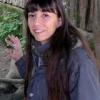Humans and other animals have a strong propensity to explore the environment. When human infants, as well as other primates, face the opportunity to interact with the environment by manipulating objects, they may discover and learn the contingency between one action and its outcome. Thus, manipulation, as a form of spontaneous exploration, has a great biological significance, since it allows to discover and learn the relationship between action and effect, enabling humans and other animals to plan goal-directed tasks. How do the specific characteristics of the primate's body influence this process? With its large amount of degrees of freedom, sensors, and nervous terminations, the hand is the main interface with the external world, and it profoundly influences the primates' interaction with the environment. How does object exploration mediated by manual actions affect the acquisition of problem-solving abilities? To try to answer this question, we experimentally compared how children and capuchin monkeys (Sapajus spp.)-- nonhuman primates well known for their manual dexterity and for being curious and highly manipulative--acquire new cause-effect relations through spontaneous manual exploration of a new environment. The experiments were carried out with the mechatronic board, an innovative device specifically designed to allow interspecies comparative research. The board allowed testing whether spontaneous manipulation of objects (not instrumental to achieve any specific goal) improved subjects' ability to solve a subsequent goal-directed task by retrieving the knowledge learned during previous exploration.
Primates' propensity to explore objects: How manual actions affect learning in children and capuchin monkeys
Publication type:
Contributo in volume
Publisher:
Springer International Publishing AG, Berlin, DEU
Source:
The Hand, Studies in Applied Philosophy, Epistemology and Rational Ethics, edited by M. Bertolaso, N. Di Stefano, pp. 55–73. Berlin: Springer International Publishing AG, 2017
Date:
2017
Resource Identifier:
http://www.cnr.it/prodotto/i/377457
https://dx.doi.org/10.1007/978-3-319-66881-9_4
info:doi:10.1007/978-3-319-66881-9_4
http://www.scopus.com/record/display.url?eid=2-s2.0-85030118650&origin=inward
Language:
Eng




